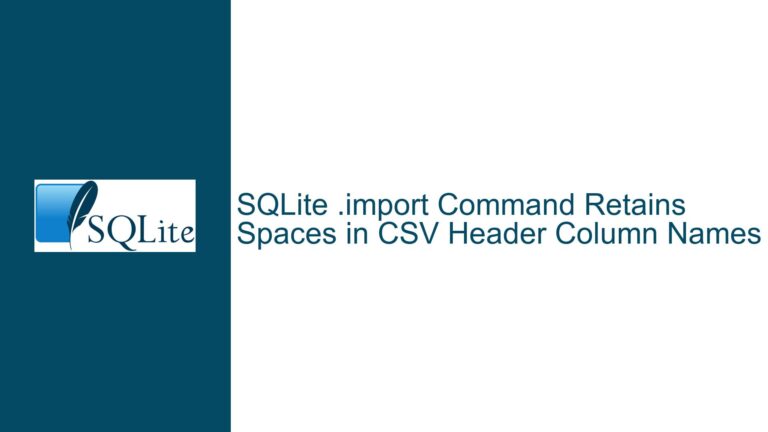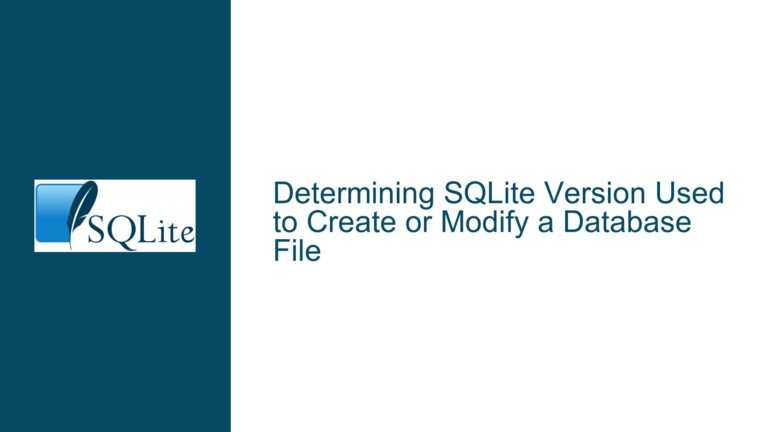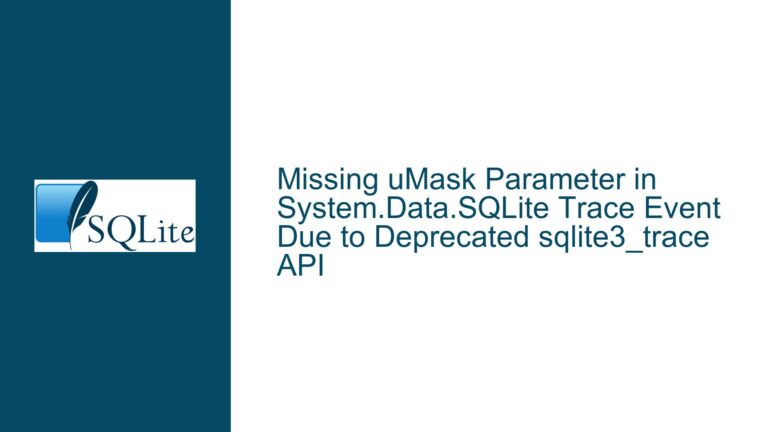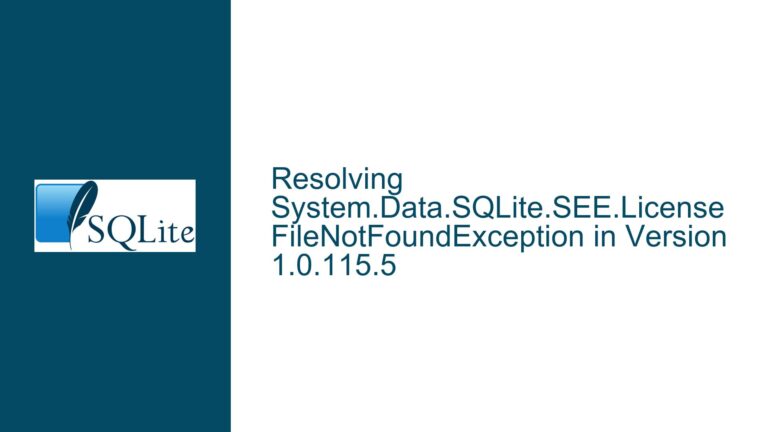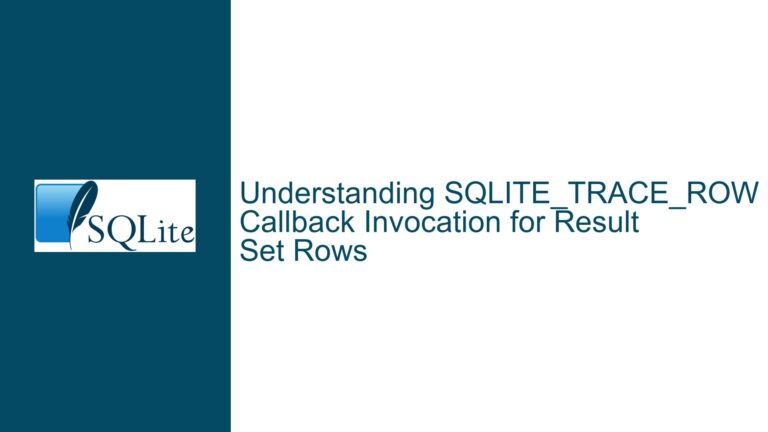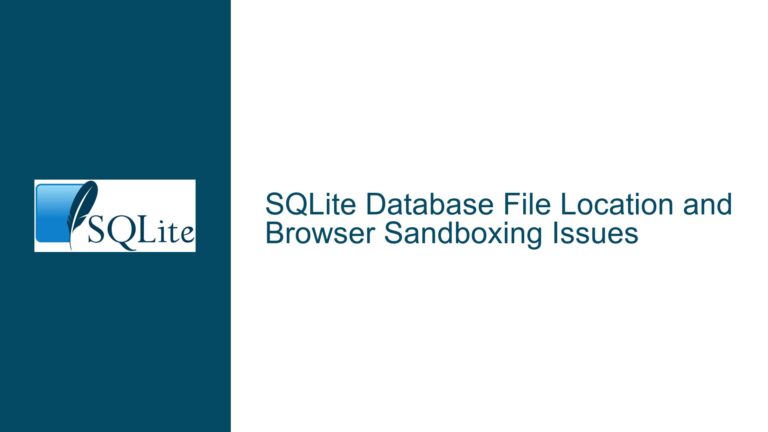SQLite3 Arrow Key and Terminal Line Wrap Issues in VSCode WSL Terminal
Issue Overview: Arrow Key Input and Terminal Line Wrap Behavior in SQLite3 on VSCode WSL Terminal
When using SQLite3 in the Visual Studio Code (VSCode) terminal with the Windows Subsystem for Linux (WSL) running Ubuntu 20.04, users may encounter two distinct but related issues. The first issue involves the arrow keys (up, down, left, right) not functioning as expected within the SQLite3 command-line interface (CLI). Instead of navigating through command history or moving the cursor within the current command, the terminal displays escape sequences such as ^[[A, ^[[B, ^[[D, and ^[[C. This behavior indicates that the terminal is not interpreting the arrow key inputs correctly.
The second issue pertains to terminal line wrapping behavior. When entering a long command that exceeds the width of the terminal, the text wraps around but overwrites the bottom line instead of scrolling the terminal window and continuing the text on a new line. This issue is particularly noticeable in the VSCode terminal and is likely related to how the terminal emulator handles ANSI escape sequences and line wrapping.
Both issues are symptomatic of underlying configuration or compatibility problems between SQLite3, the terminal emulator, and the libraries that facilitate terminal interaction, such as GNU Readline or libedit. These problems are exacerbated when using SQLite3 versions compiled from source, as opposed to pre-packaged versions installed via package managers like apt.
Possible Causes: Missing Readline Support and Terminal Emulator Limitations
The arrow key issue is primarily caused by the absence or misconfiguration of the GNU Readline library during the compilation of SQLite3. The GNU Readline library provides line-editing capabilities, including command history navigation and cursor movement, which are essential for a smooth user experience in the SQLite3 CLI. When SQLite3 is compiled without Readline support, it cannot interpret the arrow key inputs correctly, resulting in the display of raw escape sequences.
The terminal line wrap issue, on the other hand, is likely due to limitations or bugs in the VSCode terminal emulator’s handling of ANSI escape sequences. The VSCode terminal, which is based on xterm.js, may not fully support certain ANSI X3.64 standards, particularly those related to line wrapping and scrolling. This issue is compounded when using WSL, as the interaction between the Windows host and the Linux guest can introduce additional layers of complexity and potential incompatibilities.
Troubleshooting Steps, Solutions & Fixes: Ensuring Readline Support and Addressing Terminal Emulator Limitations
1. Ensuring Readline Support in SQLite3
To resolve the arrow key issue, the first step is to ensure that SQLite3 is compiled with GNU Readline support. This involves installing the necessary development libraries and headers for Readline and verifying that the SQLite3 configure script detects and links against them correctly.
Step 1.1: Install GNU Readline Development Libraries
On Ubuntu 20.04, the GNU Readline development libraries can be installed using the following command:
sudo apt install libreadline-dev
This command installs both the libreadline library and the libreadline-dev package, which includes the necessary headers for compiling SQLite3 with Readline support.
Step 1.2: Verify Readline Detection During SQLite3 Compilation
After installing the development libraries, re-run the SQLite3 configure script to ensure that it detects Readline correctly. The configure script should output messages indicating that it has found the Readline library and headers:
checking for readline in -lreadline... yes
checking readline.h usability... yes
checking readline.h presence... yes
checking for readline.h... yes
If the script reports that it cannot find the Readline library or headers, double-check that the libreadline-dev package is installed correctly and that the necessary files are present in the expected locations (e.g., /usr/include/readline/readline.h).
Step 1.3: Recompile SQLite3 with Readline Support
Once the configure script confirms that Readline is available, proceed with compiling SQLite3 as usual:
./configure
make
sudo make install
After recompiling and installing SQLite3, launch the SQLite3 CLI and verify that the arrow keys now function as expected, allowing you to navigate through command history and move the cursor within the current command.
2. Addressing Terminal Emulator Limitations in VSCode
The terminal line wrap issue is more challenging to resolve, as it is rooted in the limitations of the VSCode terminal emulator. However, there are several steps you can take to mitigate the problem or work around it.
Step 2.1: Verify Terminal Emulator Configuration
First, ensure that the VSCode terminal is configured to use the correct shell and that it is set to emulate a terminal type that supports the necessary ANSI escape sequences. In the VSCode settings, check that the terminal.integrated.shell.linux option is set to the correct shell (e.g., /bin/bash for Bash) and that the terminal.integrated.env.linux option does not override any critical environment variables.
Step 2.2: Adjust Terminal Width and Height
The line wrap issue may be less pronounced if the terminal is set to a wider width. Try increasing the width of the VSCode terminal window to see if this reduces the frequency of line overwriting. You can also experiment with adjusting the terminal’s height to see if it affects the scrolling behavior.
Step 2.3: Use an Alternative Terminal Emulator
If the VSCode terminal continues to exhibit problematic behavior, consider using an alternative terminal emulator that is known to have better support for ANSI escape sequences. For example, you can use the Windows Terminal application, which has improved support for WSL and ANSI escape sequences compared to the default VSCode terminal.
To use Windows Terminal with VSCode, you can configure VSCode to launch an external terminal emulator instead of using its built-in terminal. This can be done by modifying the terminal.integrated.shell.linux setting to point to a script that launches Windows Terminal with the appropriate WSL distribution.
Step 2.4: Report and Monitor VSCode Terminal Issues
Since the line wrap issue is likely a bug or limitation in the VSCode terminal emulator, it is important to report the issue to the VSCode development team and monitor any updates or fixes. You can file an issue on the VSCode GitHub repository, providing detailed information about the problem, including steps to reproduce it and any relevant screenshots or videos.
3. Alternative Solutions and Workarounds
If the above steps do not fully resolve the issues, there are alternative solutions and workarounds that you can consider.
Step 3.1: Use Pre-Packaged SQLite3 Versions
If compiling SQLite3 with Readline support proves to be too cumbersome, consider using the pre-packaged version of SQLite3 available in the Ubuntu repositories. This version is typically compiled with Readline support and should work correctly out of the box:
sudo apt install sqlite3
Step 3.2: Use a Different Terminal Application
If the VSCode terminal continues to cause problems, consider using a different terminal application altogether. For example, you can use a standalone terminal emulator like gnome-terminal or konsole within your WSL environment. These terminal emulators are more likely to handle ANSI escape sequences correctly and provide a better user experience.
Step 3.3: Modify SQLite3 Command-Line Behavior
As a last resort, you can modify the behavior of the SQLite3 CLI to avoid relying on arrow key navigation and line wrapping. For example, you can use the .read command to execute SQL commands from a file, or you can use a text editor to compose SQL commands and then paste them into the SQLite3 CLI.
Conclusion
The issues with arrow key input and terminal line wrapping in SQLite3 on the VSCode WSL terminal are primarily caused by missing Readline support and limitations in the terminal emulator’s handling of ANSI escape sequences. By ensuring that SQLite3 is compiled with Readline support and addressing the terminal emulator’s limitations, you can significantly improve the user experience. However, some issues may require workarounds or alternative solutions, particularly if they are rooted in the terminal emulator itself. By following the troubleshooting steps outlined above, you can resolve these issues and enjoy a more seamless SQLite3 CLI experience in the VSCode WSL terminal.

